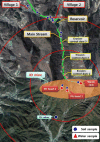Exposure assessment for the abandoned metal mine area contaminated by arsenic
- PMID: 31016607
- PMCID: PMC6856293
- DOI: 10.1007/s10653-019-00296-5
Exposure assessment for the abandoned metal mine area contaminated by arsenic
Abstract
Among the results of community health impact assessments completed in 2014, residents of the Indae abandoned metal mine area showed high average urinary concentrations of harmful arsenic (As), at 148.9 µg/L. The concentration of harmful As was derived as the sum of As(V), As(III), MMA, and DMA concentrations known to be toxic. In this area, mining hazard prevention work was not carried out and the pollution source was neglected, and the health effect of the residents due to arsenic exposure was concerned. We re-assessed As exposure levels and tried to identify exposure factors for residents of this area. Analysis of the soil, sediment, and river water to assess the association between the soil of the Indae abandoned metal mine area and the soil in residential areas confirmed a correlation between Pb and As concentrations in the soil. Since Pb and As behave similarly, the use of the stable Pb isotope ratio for assessment of the pollution source tracking was validated. In the 3-isotope plot (207/206Pb vs. 208/206Pb) of soil samples in this area, a stable Pb isotope ratio was located on the same trend line, which confirmed that the soil in the residential area was within the area of influence of the Indae abandoned metal mine. Therefore, we judged that the pollution source of As was the Indae abandoned metal mine. The results by As species were As (III) 1.45 μg/L, As (V) 0.74 μg/L, monomethylarsonic acid (MMA) 2.43 μg/L, dimethylarsinic acid (DMA) 27.63 μg/L, and arsenobetaine 88.62 μg/L. The urinary harmful As was 31.92 μg/L, much lower than the 148.9 μg/L reported in a 2014 survey, due to the implementation of a multi-regional water supply in November 2014 that restricted As exposure through drinking river water. However, concerns remain over chronic exposure to As because As in river water used for farming and in agricultural soil still exceeds environmental standards; thus, ongoing work to address hazards from former mining areas and continued environmental monitoring is necessary.
Keywords: Abandoned metal mine; Arsenic; Exposure assessment; Stable Pb isotope ratio.
Figures







References
-
- ACGIH (American Conference of Governmental Industrial Hygienists). (2006). Threshold limit values for chemical substances and physical agents & biological exposure indices.
-
- ATSDR (Agency for Toxic Substances and Disease Registry). (2007). Toxicology profile for arsenic. Division of Toxicology and Human Health Sciences, Atlanta, Georgia, USA. https://www.atsdr.cdc.gov/toxprofiles/tp.asp?id=22&tid=3. Accessed April 18, 2014.
-
- CDC (Centers for Disease Control and Prevention). (2015). Fourth national report on human exposure to environmental chemicals. Atlanta, Georgia, USA, p. 163.
MeSH terms
Substances
Grants and funding
LinkOut - more resources
Full Text Sources
Medical
Research Materials

